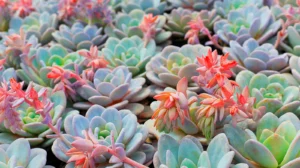Succulents are known for their ability to store water in their leaves, stems, and roots, making them highly adaptable to arid environments. However, despite their resilience, succulents still require proper care and attention to thrive. One important aspect of succulent care is fertilization. Fertilizing succulents can greatly improve their health and appearance by providing them with the essential nutrients they need to grow and flourish.
Fertilization is the process of adding nutrients to the soil to promote plant growth. For succulents, fertilization is crucial because it helps replenish the nutrients that may be lacking in their natural habitat or depleted over time in potted plants. By providing the necessary nutrients, fertilization can enhance the overall health and vigor of succulents, resulting in stronger roots, increased resistance to pests and diseases, and vibrant foliage.
Understanding Nutrient Requirements of Succulents
To effectively fertilize succulents, it is important to understand their nutrient requirements. Like all plants, succulents require a combination of essential nutrients for optimal growth. These nutrients can be divided into two categories: macronutrients and micronutrients.
Macronutrients are needed in larger quantities and include nitrogen (N), phosphorus (P), and potassium (K). Nitrogen is responsible for promoting leaf and stem growth, phosphorus aids in root development and flowering, while potassium helps with overall plant health and disease resistance.
Micronutrients are required in smaller amounts but are equally important for succulent growth. These include iron (Fe), manganese (Mn), zinc (Zn), copper (Cu), boron (B), molybdenum (Mo), and chlorine (Cl). Micronutrients play a vital role in various physiological processes such as photosynthesis, enzyme activation, and nutrient uptake.
Types of Fertilizers for Succulents
There are several types of fertilizers available for succulents, each with its own advantages and disadvantages. The most common types include granular fertilizers, liquid fertilizers, and slow-release fertilizers.
Granular fertilizers are solid pellets or granules that are applied to the soil surface and slowly release nutrients over time. They are easy to use and provide a steady supply of nutrients to the plants. However, they can be difficult to distribute evenly and may require frequent reapplication.
Liquid fertilizers are mixed with water and applied directly to the soil or sprayed onto the foliage. They are quickly absorbed by the plants, making them an efficient option for providing immediate nutrition. However, they may require more frequent applications and can be easily overused, leading to nutrient imbalances.
Slow-release fertilizers are formulated to release nutrients gradually over an extended period. They come in various forms such as spikes, pellets, or coated granules. Slow-release fertilizers offer convenience as they only need to be applied once or twice a season. However, they may not provide an immediate nutrient boost and can be more expensive compared to other types of fertilizers.
Organic vs. Synthetic Fertilizers for Succulents
When it comes to choosing a fertilizer for succulents, gardeners have the option of using organic or synthetic fertilizers. Organic fertilizers are derived from natural sources such as compost, manure, bone meal, and seaweed. They provide a slow and steady release of nutrients and improve soil structure and fertility over time. Organic fertilizers are also environmentally friendly and promote beneficial microbial activity in the soil. However, they may have lower nutrient concentrations compared to synthetic fertilizers and can take longer to show results.
On the other hand, synthetic fertilizers are manufactured using chemical compounds that provide a concentrated source of nutrients. They are readily available and offer precise control over nutrient ratios. Synthetic fertilizers are fast-acting and can produce quick results. However, they can be harsh on the environment and may lead to nutrient imbalances if not used correctly.
How to Apply Fertilizer to Succulents
Applying fertilizer to succulents requires careful consideration of the plant’s needs and the type of fertilizer being used. Here is a step-by-step guide on how to apply fertilizer to succulents:
1. Choose the right fertilizer: Select a fertilizer that is specifically formulated for succulents or one that has a balanced NPK ratio (e.g., 10-10-10).
2. Dilute liquid fertilizers: If using a liquid fertilizer, dilute it according to the manufacturer’s instructions. Avoid over-concentrating the solution as it can burn the plants.
3. Apply granular or slow-release fertilizers: Sprinkle granular or slow-release fertilizers evenly around the base of the plants, taking care not to let them touch the leaves or stems.
4. Water thoroughly: After applying the fertilizer, water the plants thoroughly to help distribute the nutrients into the soil.
5. Follow recommended frequency: Refer to the fertilizer packaging or consult a gardening expert for guidance on how often to fertilize your succulents. Generally, it is recommended to fertilize succulents once every 2-4 weeks during the growing season.
Frequency of Fertilization for Succulents
The frequency of fertilization for succulents depends on various factors such as the type of fertilizer used, the growth stage of the plants, and environmental conditions. As a general rule, succulents should be fertilized more frequently during their active growing season, which is typically spring and summer.
During this period, succulents are actively producing new growth and require more nutrients to support their development. Fertilizing once every 2-4 weeks is usually sufficient to meet their nutritional needs. However, it is important to monitor the plants closely and adjust the frequency if necessary. If the succulents show signs of nutrient deficiencies or slow growth, it may be necessary to increase the frequency of fertilization.
In contrast, during the dormant season, which is usually fall and winter, succulents require less fertilizer as their growth slows down. Fertilizing once every 6-8 weeks or suspending fertilization altogether during this period is generally recommended.
Common Mistakes to Avoid when Fertilizing Succulents
While fertilizing succulents can greatly benefit their growth and health, there are some common mistakes that gardeners should avoid to prevent damage to the plants. Here are a few common mistakes to watch out for:
1. Over-fertilization: Applying too much fertilizer can lead to nutrient imbalances and burn the roots of succulents. Always follow the recommended dosage and frequency specified on the fertilizer packaging.
2. Under-fertilization: Neglecting to fertilize succulents can result in nutrient deficiencies and stunted growth. Be sure to provide regular fertilization during the growing season to support healthy plant development.
3. Incorrect nutrient ratios: Using a fertilizer with an imbalanced NPK ratio can lead to nutrient deficiencies or excesses. Choose a fertilizer with a balanced ratio or one specifically formulated for succulents.
4. Fertilizing during dormancy: Fertilizing succulents during their dormant period can disrupt their natural growth cycle. Avoid fertilizing during fall and winter unless the plants show signs of nutrient deficiencies.
5. Fertilizing dry soil: Applying fertilizer to dry soil can cause root burn and reduce nutrient uptake. Always water the plants before applying fertilizer to ensure proper absorption.
Signs of Over-Fertilization in Succulents
Over-fertilization can have detrimental effects on succulents and should be addressed promptly. Here are some signs to look out for that may indicate over-fertilization:
1. Leaf burn: The tips or edges of the leaves may turn brown or black, indicating that the plants are experiencing fertilizer burn.
2. Wilting or drooping: Over-fertilized succulents may exhibit signs of wilting or drooping, even when the soil is moist.
3. Stunted growth: Excessive fertilizer can hinder plant growth, resulting in stunted or distorted leaves and stems.
4. Yellowing leaves: Over-fertilization can disrupt nutrient uptake, leading to yellowing or chlorosis of the leaves.
5. Increased susceptibility to pests and diseases: Succulents that are over-fertilized may become more vulnerable to pests and diseases due to weakened defenses.
If any of these signs are observed, it is important to flush the soil with water to remove excess fertilizer and allow the plants to recover. Adjusting the fertilization schedule and reducing the dosage may also be necessary to prevent further damage.
Troubleshooting Nutrient Deficiencies in Succulents
Nutrient deficiencies can occur in succulents when they do not receive adequate amounts of essential nutrients. Identifying and addressing these deficiencies promptly is crucial for maintaining the health and vitality of the plants. Here are some common nutrient deficiencies in succulents and their symptoms:
1. Nitrogen deficiency: Succulents lacking nitrogen may exhibit pale or yellowing leaves, stunted growth, and reduced vigor.
2. Phosphorus deficiency: Insufficient phosphorus can cause dark green or purple leaves, weak stems, and poor flowering.
3. Potassium deficiency: Succulents deficient in potassium may display scorched leaf edges, weak stems, and reduced resistance to pests and diseases.
4. Iron deficiency: Iron deficiency can lead to yellowing leaves with green veins, a condition known as chlorosis.
5. Micronutrient deficiencies: Deficiencies in micronutrients can manifest as distorted or discolored leaves, poor growth, and overall decline in plant health.
To correct nutrient deficiencies, it is important to identify the specific nutrient lacking and provide the appropriate fertilizer or supplement. Applying a balanced fertilizer or using a foliar spray containing the deficient nutrient can help rectify the deficiency. It is also important to ensure that the soil pH is within the optimal range for nutrient availability.
Conclusion: Best Practices for Fertilizing Succulents
Fertilizing succulents is an essential aspect of their care that can greatly enhance their growth and appearance. By understanding the nutrient requirements of succulents, choosing the right type of fertilizer, and applying it correctly, gardeners can ensure that their succulents receive the necessary nutrients for optimal health and vitality.
Remember to choose a fertilizer with a balanced NPK ratio or one specifically formulated for succulents. Follow the recommended frequency of fertilization, adjusting as needed based on the plants’ growth stage and environmental conditions. Avoid common mistakes such as over-fertilization or neglecting to fertilize during the growing season.
Regularly monitor your succulents for signs of over-fertilization or nutrient deficiencies and take appropriate action to rectify any issues. By following these best practices, you can enjoy healthy, thriving succulents that will bring beauty and joy to your indoor or outdoor space.
If you’re looking to learn how to fertilize succulents properly, check out this informative article on alternative transportation: the eco-friendly way to travel. It provides valuable tips and techniques for nourishing your succulents and ensuring their healthy growth. From choosing the right fertilizer to understanding the correct application methods, this article covers everything you need to know. Don’t miss out on this essential guide to keeping your succulents thriving!

















Add Comment